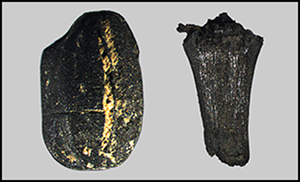Crossref Citations
This article has been cited by the following publications. This list is generated based on data provided by
Crossref.
Tian, Duo
Li, Jingbo
Wang, Yongqiang
Dang, Zhihao
Zhang, Xiangpeng
Li, Chunchang
and
Xu, Youcheng
2023.
Unveiling the Dynamics of Millet Spread into Xinjiang: New Evidence of the Timing, Pathways, and Cultural Background.
Agronomy,
Vol. 13,
Issue. 7,
p.
1802.
Eerkens, Jelmer W.
Asgari, Sepideh
Alizadeh, Karim
Malarchik, Diana
Cramer, Samantha
and
Parker, Glendon
2024.
Stable isotope and proteomic insights into Bronze age human dietary life history at Köhne Shahar, Northwest Iran.
Journal of Archaeological Science: Reports,
Vol. 58,
Issue. ,
p.
104746.
Heywood, Sullivan
Spate, Michael
Betts, Alison
Jia, Peter
and
Fairbairn, Andrew
2024.
Late Bronze Age agriculture and the early westward transmission of rice at Luanzagangzi, Northern Xinjiang, China.
The Holocene,
Vol. 34,
Issue. 2,
p.
202.
Allentoft, Morten E.
Sikora, Martin
Refoyo-Martínez, Alba
Irving-Pease, Evan K.
Fischer, Anders
Barrie, William
Ingason, Andrés
Stenderup, Jesper
Sjögren, Karl-Göran
Pearson, Alice
Sousa da Mota, Bárbara
Schulz Paulsson, Bettina
Halgren, Alma
Macleod, Ruairidh
Jørkov, Marie Louise Schjellerup
Demeter, Fabrice
Sørensen, Lasse
Nielsen, Poul Otto
Henriksen, Rasmus A.
Vimala, Tharsika
McColl, Hugh
Margaryan, Ashot
Ilardo, Melissa
Vaughn, Andrew
Fischer Mortensen, Morten
Nielsen, Anne Birgitte
Ulfeldt Hede, Mikkel
Johannsen, Niels Nørkjær
Rasmussen, Peter
Vinner, Lasse
Renaud, Gabriel
Stern, Aaron
Jensen, Theis Zetner Trolle
Scorrano, Gabriele
Schroeder, Hannes
Lysdahl, Per
Ramsøe, Abigail Daisy
Skorobogatov, Andrei
Schork, Andrew Joseph
Rosengren, Anders
Ruter, Anthony
Outram, Alan
Timoshenko, Aleksey A.
Buzhilova, Alexandra
Coppa, Alfredo
Zubova, Alisa
Silva, Ana Maria
Hansen, Anders J.
Gromov, Andrey
Logvin, Andrey
Gotfredsen, Anne Birgitte
Henning Nielsen, Bjarne
González-Rabanal, Borja
Lalueza-Fox, Carles
McKenzie, Catriona J.
Gaunitz, Charleen
Blasco, Concepción
Liesau, Corina
Martinez-Labarga, Cristina
Pozdnyakov, Dmitri V.
Cuenca-Solana, David
Lordkipanidze, David O.
En’shin, Dmitri
Salazar-García, Domingo C.
Price, T. Douglas
Borić, Dušan
Kostyleva, Elena
Veselovskaya, Elizaveta V.
Usmanova, Emma R.
Cappellini, Enrico
Brinch Petersen, Erik
Kannegaard, Esben
Radina, Francesca
Eylem Yediay, Fulya
Duday, Henri
Gutiérrez-Zugasti, Igor
Merts, Ilya
Potekhina, Inna
Shevnina, Irina
Altinkaya, Isin
Guilaine, Jean
Hansen, Jesper
Aura Tortosa, Joan Emili
Zilhão, João
Vega, Jorge
Buck Pedersen, Kristoffer
Tunia, Krzysztof
Zhao, Lei
Mylnikova, Liudmila N.
Larsson, Lars
Metz, Laure
Yepiskoposyan, Levon
Pedersen, Lisbeth
Sarti, Lucia
Orlando, Ludovic
Slimak, Ludovic
Klassen, Lutz
Blank, Malou
González-Morales, Manuel
Silvestrini, Mara
Vretemark, Maria
Nesterova, Marina S.
Rykun, Marina
Rolfo, Mario Federico
Szmyt, Marzena
Przybyła, Marcin
Calattini, Mauro
Sablin, Mikhail
Dobisíková, Miluše
Meldgaard, Morten
Johansen, Morten
Berezina, Natalia
Card, Nick
Saveliev, Nikolai A.
Poshekhonova, Olga
Rickards, Olga
Lozovskaya, Olga V.
Gábor, Olivér
Uldum, Otto Christian
Aurino, Paola
Kosintsev, Pavel
Courtaud, Patrice
Ríos, Patricia
Mortensen, Peder
Lotz, Per
Persson, Per
Bangsgaard, Pernille
de Barros Damgaard, Peter
Vang Petersen, Peter
Martinez, Pilar Prieto
Włodarczak, Piotr
Smolyaninov, Roman V.
Maring, Rikke
Menduiña, Roberto
Badalyan, Ruben
Iversen, Rune
Turin, Ruslan
Vasilyev, Sergey
Wåhlin, Sidsel
Borutskaya, Svetlana
Skochina, Svetlana
Sørensen, Søren Anker
Andersen, Søren H.
Jørgensen, Thomas
Serikov, Yuri B.
Molodin, Vyacheslav I.
Smrcka, Vaclav
Merts, Victor
Appadurai, Vivek
Moiseyev, Vyacheslav
Magnusson, Yvonne
Kjær, Kurt H.
Lynnerup, Niels
Lawson, Daniel J.
Sudmant, Peter H.
Rasmussen, Simon
Korneliussen, Thorfinn Sand
Durbin, Richard
Nielsen, Rasmus
Delaneau, Olivier
Werge, Thomas
Racimo, Fernando
Kristiansen, Kristian
and
Willerslev, Eske
2024.
Population genomics of post-glacial western Eurasia.
Nature,
Vol. 625,
Issue. 7994,
p.
301.
安, 婷
朱, 萝雅
田, 洁
温, 成浩
杨, 猛
郝, 红星
Magda, LAZAROVICI
and
Gheorghe, LAZAROVICI
2024.
公元前第二千纪以来东欧平原西南部黍作物的利用.
SCIENTIA SINICA Terrae,
An, Ting
Zhu, Luoya
Tian, Jie
Wen, Chenghao
Yang, Meng
Hao, Hongxing
Lazarovici, Magda
and
Lazarovici, Gheorghe
2025.
Broomcorn millet cultivation in the SW East European Plain since the second millennium BC.
Science China Earth Sciences,
Vol. 68,
Issue. 2,
p.
487.
Trębicka, Joanna
Dehpahlavan, Mostafa
Fetner, Rafał
Alinezhad, Zahra
Farnam, Elham
Mollabeirami, Marjan
and
Sołtysiak, Arkadiusz
2025.
Isotopic Insight Into the Human Diet at Qareh Tepe, Iran, During the Iron Age (c. 1200–750 bce).
International Journal of Osteoarchaeology,
Vol. 35,
Issue. 2,
